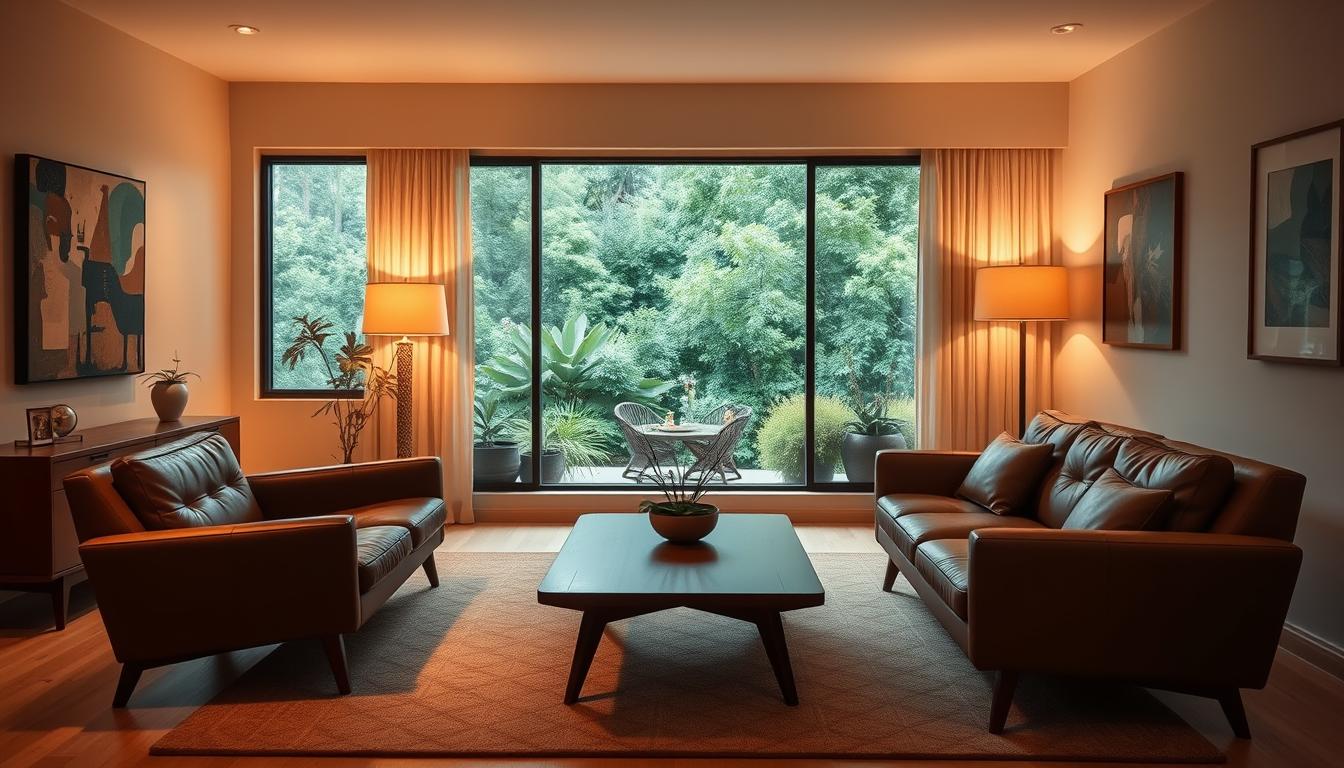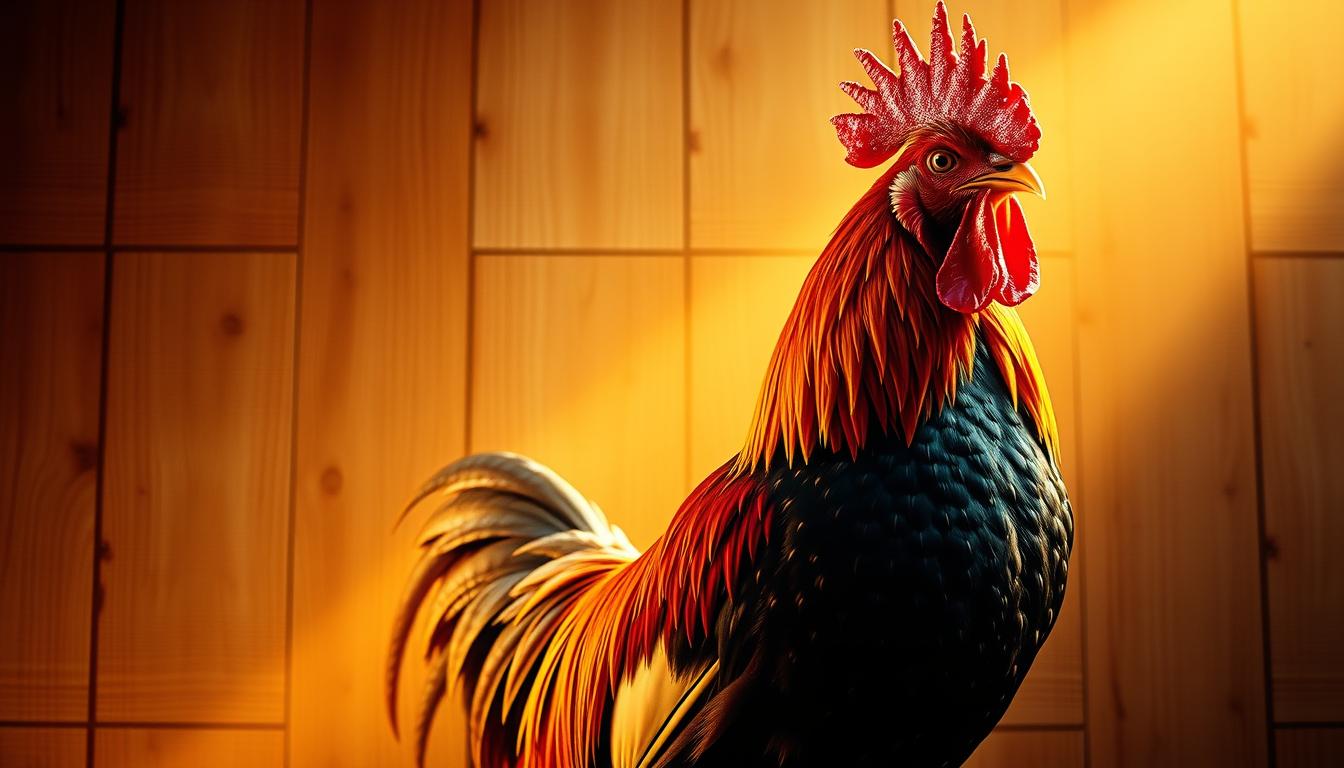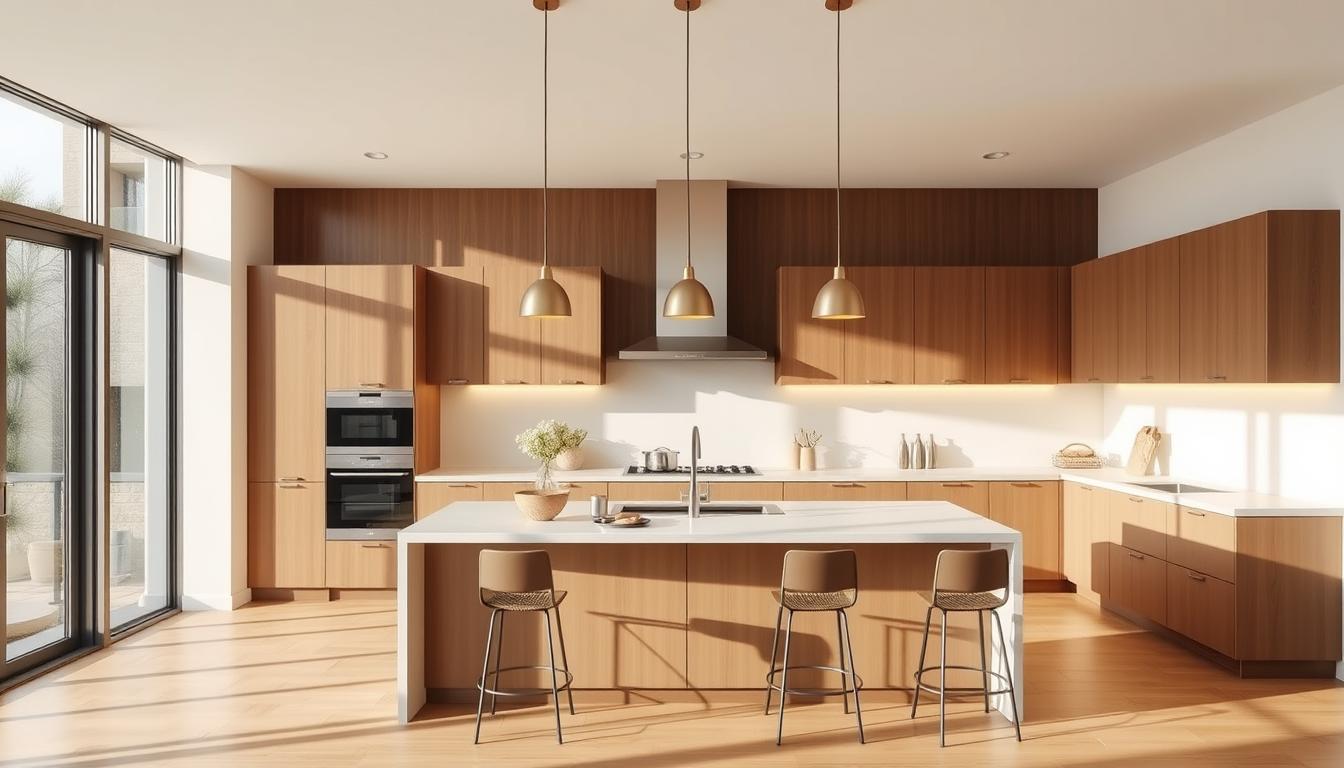The 1950s was a decade of big change for mid-century modern design. It mixed function with a look to the future. Did you know over 15 million vintage homes from then are still around? They’re waiting to be brought back to their former beauty.
Bringing a 1950s home back to life is a chance to mix old charm with today’s needs.
We’ll show you how to make your vintage design shine like new again. We’ll talk about the era’s design basics and picking the perfect retro decor and furniture. You’ll learn the best ways to make your atomic age style home look great today.
Key Takeaways
- Understand the key design elements of the 1950s era.
- Learn how to incorporate contemporary elements into your vintage design.
- Discover the right retro decor and furniture for your mid-century modern home.
- Explore the top tips for restoring your atomic age style abode.
- Blend nostalgic charm with modern functionality.
Understanding 1950s Home Aesthetics
To bring a 1950s home back to life, knowing its design is key. The 1950s were all about bold, vibrant designs. These were shaped by post-war optimism and new materials and tech.
Key Design Elements
The 1950s home design stands out with bold colors, geometric patterns, and a focus on function. New materials like plastics, aluminum, and vinyl were big. For example, Formica countertops and backsplashes were common in kitchens.
Some key features of 1950s design include:
- Clean lines and less ornamentation
- A focus on being useful and practical
- Bright, bold colors and patterns
- Use of new materials and tech
Color Palettes and Patterns
The 1950s favored pastel hues, bold primaries, and earthy tones. Geometric shapes, florals, and abstract designs were big. Restoring a 1950s home means getting its original colors and patterns right. It’s a fun, creative journey.
For more on 1950s interior design, check out Retro Renovation. It offers a detailed look at the era’s design trends.
| Color Palette | Common Colors | Pattern Styles |
|---|---|---|
| Pastel | Pink, Baby Blue, Mint Green | Geometric, Floral |
| Bold Primary | Red, Blue, Yellow | Abstract, Chevron |
| Earth Tones | Beige, Brown, Turquoise | Natural Textures, Boomerang |
Iconic Furniture Styles of the Era
Mid-century modern furniture is known for its clean lines and organic shapes. It has a timeless appeal that still inspires today. The 1950s was a key time for interior design, with furniture being a big part of the era’s look.
Mid-Century Modern
Mid-century modern furniture focuses on being functional, simple, and natural. It uses new materials and tech for innovative designs. Clean lines, minimal ornamentation, and a connection to nature are what make mid-century modern furniture special.
Classic Pieces to Consider
When picking furniture for a 1950s-style home, look for classic pieces that follow the era’s design rules. Some must-haves include:
- Eames chairs, known for their molded plywood and leather upholstery
- Noguchi coffee tables, with their simple, sculptural design
- Sleek sofas with tapered legs, showing the era’s love for clean lines and minimalism
| Furniture Piece | Description | Key Features |
|---|---|---|
| Eames Chair | Molded plywood and leather upholstery | Comfortable, ergonomic design |
| Noguchi Coffee Table | Simple, sculptural design | Glass top, wooden or metal base |
| Sleek Sofa | Tapered legs, minimalist design | Clean lines, comfortable seating |
Adding these iconic furniture styles to your home can give it a real 1950s vibe. The trick is to mix function with style, making a space that’s both lovely and practical.
Wall Art and Decorative Touches
Wall art and decorative elements are key to 1950s home style. They add a nostalgic charm. Exploring retro decor shows how these elements can make a space feel like a nostalgic haven.
Popular Wall Art Styles
The 1950s had many wall art styles. These styles showed the era’s culture and art. Some top styles include:
- Abstract Expressionism: Known for bold colors and emotive brushstrokes, this art was common in 1950s homes.
- Retro Posters: Retro ads and posters were both useful and decorative.
- Vintage Prints: Prints of famous artworks or nostalgic scenes added sophistication and nostalgia.
Life Magazine said, “The way we decorate our homes shows our personality and times.” This captures the 1950s home decor spirit, where wall art was key.
Adding Vintage Accents
Vintage accents also enhance a 1950s home’s feel. Consider adding:
- Antique Clocks: A vintage clock brings elegance and nostalgia.
- Vintage Mirrors: Ornate mirrors add depth and luxury.
- Retro-Themed Accessories: Vintage vases, retro textiles, and more complete the look.
Using these wall art styles and vintage accents makes a space truly 1950s. As the saying goes, “The devil is in the details.” These touches make a house a home.
“Good design is good business.” –
This 1950s mantra shows the value of aesthetics in our homes. Embracing retro decor and vintage design creates a beautiful, functional space.
Flooring Options from the 1950s
To capture the essence of 1950s home decor, it’s key to look at the flooring options from back then. Flooring was a big part of 1950s homes, focusing on both durability and style.
Tile and Linoleum Choices
Tile and linoleum were big in 1950s flooring because they were practical and versatile. Geometric patterns and bold colors were favorites, adding a unique touch to homes.
Tile flooring was tough and came in many designs, from simple to complex. Linoleum, by contrast, offered a uniform look and was easy to clean.
Area Rugs for Authenticity
Area rugs were used to add warmth and authenticity to rooms. They often had traditional or vintage designs, helping to complete the room’s look.
When picking area rugs for a 1950s vibe, go for designs like Persian or Moroccan patterns. These add a cozy and authentic feel to your space.
“The right flooring can completely transform a room, making it feel more authentic and connected to its era.”
Revamping the Kitchen
To make your kitchen look like it’s from the 1950s, mix old charm with modern design. Kitchens back then were both stylish and practical. They were the heart of the home.
1950s Kitchen Layouts
Kitchens from the 1950s were all about being efficient. They had appliances and fixtures that made cooking easier. You’d often find a prominent kitchen table or a breakfast nook, perfect for family gatherings.
House Beautiful once said, “The kitchen is the heart of the home, where meals are prepared with love and memories are made.” This idea shaped 1950s kitchens, making them warm and useful.
Essential Appliances and Features
Key items in a 1950s kitchen include retro-style refrigerators and vintage stoves. They were not just useful but also decorative. Formica countertops were also common, offering durability and a modern look.
- Retro-style refrigerators with bold colors
- Vintage stoves that add a nostalgic touch
- Formica countertops for a sleek, modern appearance
- Checkered or geometric patterned flooring
By adding these elements, we can make a kitchen that honors the past while meeting today’s needs. “The key to a successful retro kitchen is balancing nostalgia with modern needs,” design experts say.
Living Room: Center of Social Life
Walking into a 1950s-inspired living room feels like stepping into a warm, welcoming space. This room was the heart of 1950s homes. It was designed to be cozy and reflect the era’s love for family and social gatherings.
Classic Seating Arrangements
In 1950s living rooms, you’d find sleek sofas and armchairs that were both stylish and comfy. These pieces were made of durable, easy-to-clean materials. They were set up to encourage talking and socializing.
- Sleek, low-profile sofas with clean lines
- Accent armchairs with tapered legs
- Ottomans for added versatility
These seating setups showed off the era’s design and values. They focused on comfort and bringing people together.
Statement Lighting Choices
Lighting in 1950s living rooms was more than just functional. It was a statement that added to the room’s feel and style. Sputnik chandeliers and table lamps with unique designs were big hits. They brought a futuristic vibe to the space.
Some iconic lighting choices include:
- Sputnik chandeliers with multiple arms and globe lights
- Table lamps with sculptural bases and geometric shades
- Floor lamps with adjustable arms and metallic accents
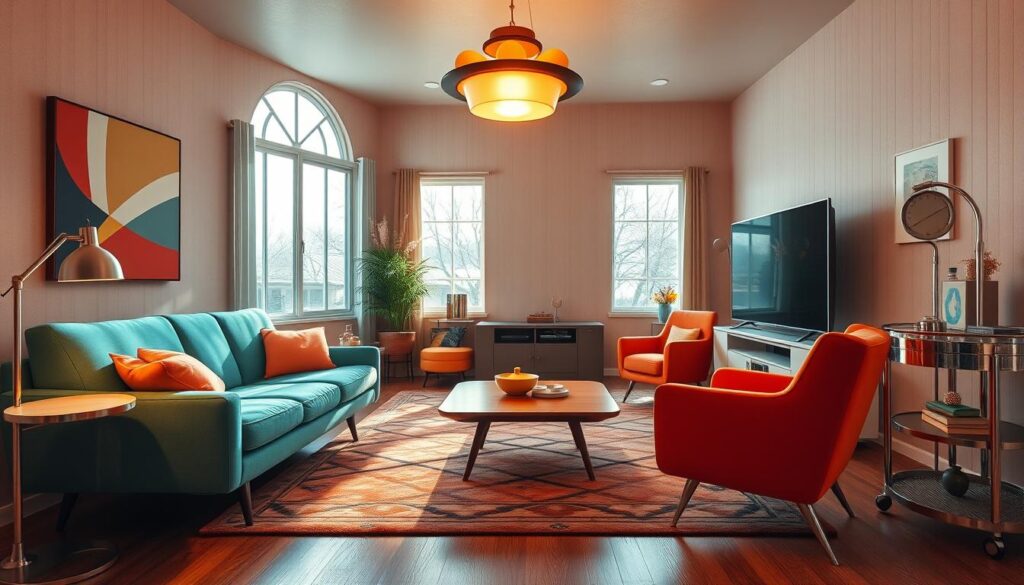
By using these classic seating and lighting choices, you can make a living room that feels like the 1950s. Yet, it will still be modern and welcoming.
Incorporating Retro Appliances
To truly capture the essence of a 1950s home, consider integrating retro appliances into your design. These appliances are not just functional. They also add a nostalgic touch that can transform your kitchen or laundry room into a vintage haven.
Choosing the Right Colors
The 1950s were known for their vibrant and bold color palettes. When selecting retro appliances, consider colors that were popular during that era. Pastel hues like mint green and powder blue, and bold primaries like red, yellow, and blue, are great choices. These colors can add a fun and playful touch to your space.
For a more authentic look, you can also consider appliances with a chrome finish or those that mimic the retro style with modern functionality. According to experts, incorporating such elements can significantly enhance the vintage appeal of your home.
Balancing Functionality and Style
While retro appliances are designed to look vintage, they should also be functional and efficient. Look for appliances that not only have a retro aesthetic but also incorporate modern technology. This ensures they meet your needs.
For instance, retro-style refrigerators now come with advanced features like through-the-door ice dispensers and multi-air flow technology. Retro-style stoves can have modern induction cooking surfaces.
| Appliance | Retro Features | Modern Features |
|---|---|---|
| Refrigerator | Vintage color options, chrome handles | Through-the-door ice dispenser, multi-air flow technology |
| Stove | Retro color schemes, classic design | Induction cooking, precise temperature control |
| Dishwasher | Retro styling, vintage-inspired controls | Quiet operation, multiple wash cycles |
By balancing retro style with modern functionality, you can create a space that is both nostalgic and practical. For more inspiration on incorporating vintage elements into your home, visit design resources that specialize in mid-century modern and retro decor.
Bathroom Revival: Vintage Vibes
Bringing back the 1950s bathroom style means embracing simplicity with a vintage charm. These bathrooms were practical yet had a unique retro appeal. Today, many homeowners want to bring back this style.
Key Features of 1950s Bathrooms
The 1950s bathrooms were known for their simple design and stylish fixtures. Some key features include:
- Pedestal sinks that added elegance
- Vintage toilets that were both functional and decorative
- Tile or linoleum flooring that was durable and easy to clean
These elements made 1950s bathrooms both nostalgic and practical. Design experts say, “The 1950s bathroom was all about marrying form and function in a stylish and practical way.”
“The 1950s was a decade that celebrated the fusion of aesthetics and utility, in bathroom design.”
Fixtures and Accessories
To get a vintage vibe in your bathroom, add fixtures and accessories from the 1950s. Some ideas include:
| Fixture/Accessory | Description |
|---|---|
| Chrome Faucets | Added a touch of luxury and shine |
| Retro-themed Shower Curtains | Brought color and pattern to the bathroom |
| Vintage-style Lighting | Provided warm and inviting illumination |
By adding these elements, you can make a bathroom that feels like the 1950s. Chrome faucets, for example, added luxury and became a key part of 1950s bathroom design.
In conclusion, reviving the 1950s bathroom style is about mixing vintage fixtures, classic design, and attention to detail. By understanding and using these elements, we can make bathrooms that are both nostalgic and useful.
Outdoor Spaces: Capturing the Era
When we go outside, our 1950s home’s patio feels like part of our living room. It captures the era’s unique charm. The 1950s were a time of big changes and new ideas, seen in outdoor designs.
Popular 1950s Patio Designs
The 1950s patio designs used natural materials and bright colors. This made the indoor and outdoor spaces feel connected. Redwood and cedar were favorites for furniture and decor, because they were strong and looked natural.
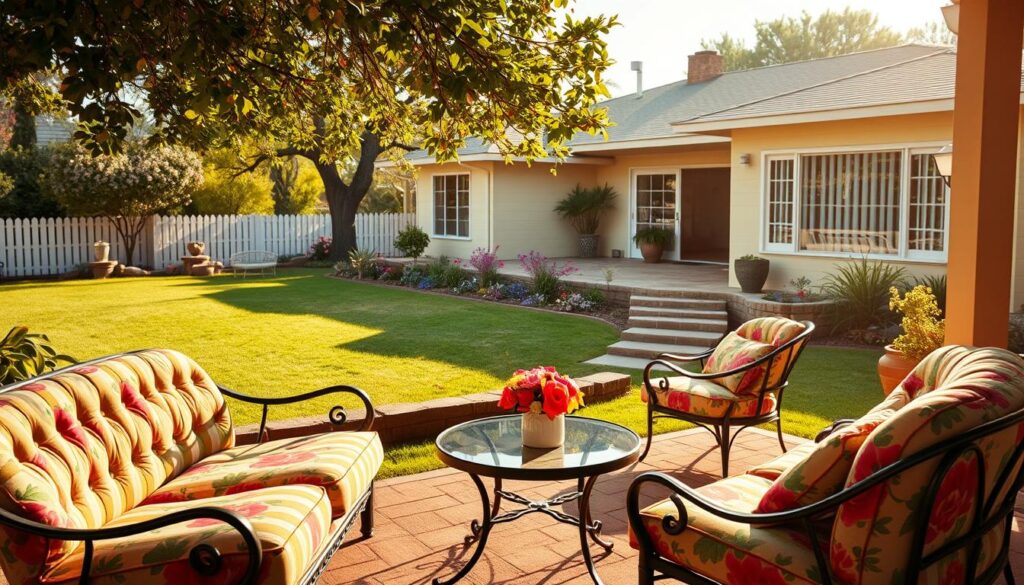
Furniture and Decorations
Furniture and decorations were key to bringing the 1950s outdoors to life. Wrought-iron patio sets were common, paired with retro planters and vintage decor. These items were not just useful but also showed off the era’s style.
| Furniture/Decor | Description | Characteristics |
|---|---|---|
| Wrought-Iron Patio Sets | Durable, elegant furniture | Intricate designs, often with a black or bronze finish |
| Retro-Themed Planters | Colorful, geometric planters | Bold colors, geometric patterns, and abstract designs |
| Vintage Outdoor Decor | Unique, nostalgic decor pieces | Often featuring mid-century modern or atomic age motifs |
By adding these elements, we can make an outdoor space that honors the 1950s. It becomes a place for both fun and relaxation.
Embracing 1950s Technology
The 1950s was a time of big changes in technology. Adding these old elements can make our homes feel more nostalgic. It’s important to see how tech shaped life and decor back then.
Technology in the 1950s changed how people lived and played at home. Things like record players, radios, and TVs were key. They bring a piece of the past into our homes today.
Record Players and Radios
Record players and radios were big in 1950s homes. They brought music and news to families. The sound of vinyl and the glow of radio tubes take us back in time.
Look for unique designs when picking out vintage record players and radios. They can be more than just entertainment; they can be decorative pieces. Models like the RCA Victor Console and the Zenith Trans-Oceanic Radio are iconic. They had beautiful designs and were part of the home’s look.
Vintage Televisions and More
Vintage TVs, with their wooden cabinets and round screens, are coming back. They add a retro charm and spark conversations. Other old tech like vintage computers and early phones can also decorate our homes.
Here’s a table that shows some key items and what makes them special:
| Device | Characteristics | Decorative Potential |
|---|---|---|
| Record Players | Vinyl playback, wooden cabinets | High, serves as a decorative piece |
| Vintage Radios | AM/FM tuning, tube technology | High, unique designs |
| Vintage Televisions | Round screens, wooden or metal cabinets | High, retro aesthetic |
By using vintage tech, we honor the past and make our homes unique. It’s a way to tell a story through our decor.
Personalizing Your 1950s Space
Personalizing a 1950s home is more than just picking decor. It’s about making the home tell your story. When we restore these homes, we can add personal touches that make them stand out.
Adding Family Heirlooms
One great way to make your 1950s home special is by adding family heirlooms. These items bring history and a personal touch to your space. Think about using vintage furniture, old photos, or decorative items that fit the mid-century modern style.
For example, an antique armchair can be updated with a new fabric. Choose something that matches the era, like a vintage print or bold color. This mix of old and new tells a story in your home.
Mixing Old and New Elements
Mixing old and new decor is another smart way to personalize your home. Combining vintage pieces with modern ones creates a balanced look. For instance, pair a vintage sofa with a modern coffee table. Or, mix retro patterns with modern art for a unique look.
Here’s a table showing how to mix old and new:
| Vintage Element | Modern Element | Combined Look |
|---|---|---|
| Antique Sideboard | Modern Pendant Lighting | Creates a striking contrast that highlights both pieces |
| Retro Color Scheme | Contemporary Artwork | Adds a fresh twist to the vintage color palette |
| Vintage Rugs | Modern Sectional Sofa | Blends comfort with vintage charm |
For more ideas, check out our top 10 home interior ideas. They can help you mix old and new beautifully.
Resources for Your Renovation Journey
Restoring our 1950s homes to their former glory is exciting. We can find inspiration from many sources. Embracing retro interiors means mixing vintage design with nostalgic home decor.
Retro Furniture Hunting
Finding the right retro furniture is key to a true 1950s look. We can search local thrift stores, antique shops, or online. This way, we find unique pieces that make our homes special.
Connecting with Fellow Design Enthusiasts
Joining design communities and forums is helpful. It gives us insights and advice on our renovation. By sharing our stories and learning from others, we create a space that’s truly ours. It honors the 1950s while showing our personal style.

